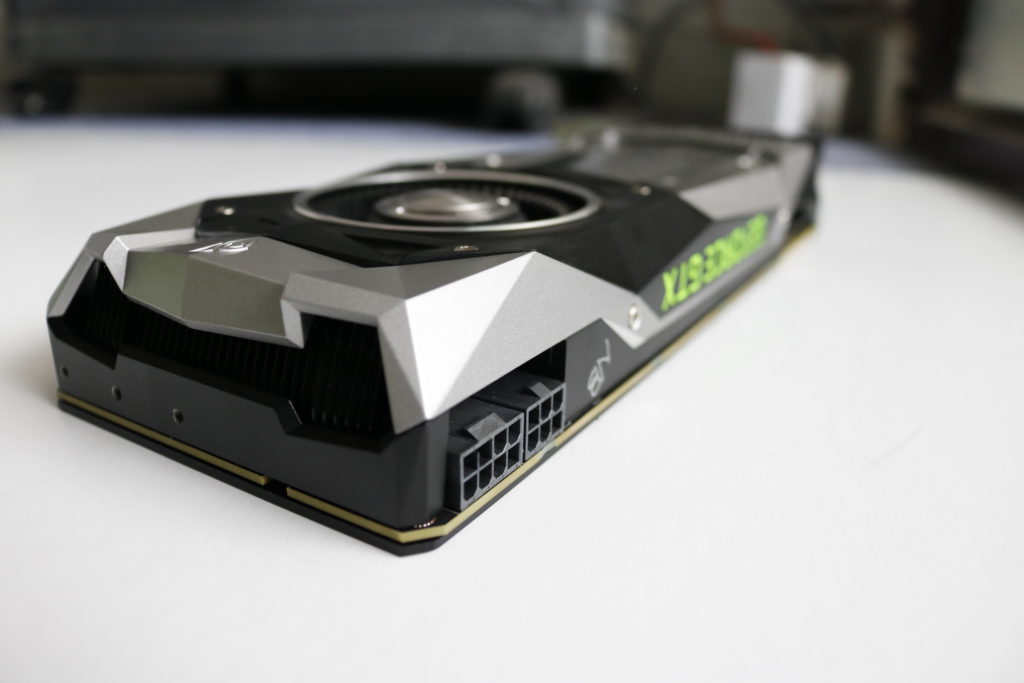Gone are the days when Titan X was the daddy of all GPUs. NVIDIA recently released the GTX 1080Ti, which boasts to be “the ultimate GeForce card”, leaving the GTX 1080 in dust and smoke. But does it live up to the hype, and more importantly, the claim? Let’s dive in.
Tech Specs
| NVIDIA CUDA Cores | 3584 |
| Base Clock | 1480 |
| Boost Clock | 1582 |
| Memory Speed | 11 Gbps |
| VRAM | 11 GB GDDR5X |
| Memory Bandwidth | 484 GB/s |
Both the Titan X Pascal and the GTX 1080Ti are based on GP102 graphics processor. Both the cards have 12 billion transistors and 3584 CUDA Cores. And while the GTX 1080Ti has a smaller number of ROP units (88 to Titan’s 96) and lesser VRAM (11GB compared to the Titan’s 12 GB), it has a higher clock speed for the GPU and memory which more than makes up for the difference.
While the Titan X is exorbitantly out of most gamers’ budget, the GTX 1080Ti’s $700 launch price seems much more reasonable. Comparing it to its non-Ti counterpart, the GTX 1080Ti is much more powerful than the GTX 1080, with over a thousand more CUDA cores (the 1080 has 2560) and higher bandwidth and texture units and much more.
Nvidia GTX 1080 Ti |
Nvidia Titan X |
GeForce GTX 1080 |
|
| Architecture | Pascal | Pascal | Pascal |
| GPU | GP102 | GP102 | GP104 |
| Fab | 16nm Finfet | 16nm Finfet | 16nm Finfet |
| CUDA Cores | 3584 | 3584 | 2560 |
| Base | 1480 MHz | 1417 MHz | 1607 MHz |
| Boost | 1582 MHz | 1531 MHz | 1733 MHz |
| Perf | 11.5 TFLOPS | 11 TFLOPS | 8,87 TFLOPS |
| Mem | 11GB GDDR5X | 12GB GDDR5X | 8 GB GDDR5X |
| Mem freq | 11000 MHz | 10000 MHz | 10000 MHz |
| Mem bus | 352-bit | 384-bit | 256-bit |
| Mem bandw | 484 GB/s | 480 GB/s | 320 GB/s |
| TDP | 250W | 250W | 180W |
The GTX 1080Ti is said to be built for handling 5K graphics, and the specifications say that the maximum supported display resolution is 7680×4320 @ 60Hz. Display options include three DisplayPorts and one HDMI port. With the Pascal architecture, the DisplayPort is 1.2 certified and 1.3/1.4 ready, capable of handling resolutions of 4K @ 120Hz, 5K @ 60Hz or 8K @ 60Hz.The GTX 1080Ti Founder’s Edition has the same design characteristic of all Founder’s Edition cards. The 225W TDP GPU uses a copper vapour chamber combined with a large dual-slot heatsink to keep it cool. The blower style cooler drives the heat out through the back of the card, and in order to ensure a larger exhaust for proper heat dissipation, NVIDIA has done away with the DVI slot on the panel, which was still present in earlier NVIDIA cards. However, the GPU does come with a DVI to DisplayPort converter. The high TDP also means that the card cannot be powered by a single power pin. Hence you need both a 6-pin and an 8-pin power connector to run the 1080Ti.
Benchmarks and Performance
For people who mostly game at Full HD (1080p), this card wouldn’t make a difference because it’s mostly likely to be bottleneck-ed by the processor. But it forms a great choice for people who want to play at higher resolutions like 2560X1440 or better yet, Ultra HD (4K).
Our test rig comprised of the GTX 1080Ti with the Ryzen 7 1800X and we chose to run the following games to test the card’s performance:
- Rise of the tomb Raider (DX 12, Very High Preset with PureHair On)
- Deus Ex: Mankind Divided (DX 12, Ultra preset)
- Watch Dogs 2 (DX 11, Ultra preset)
- Dishonored 2 (DX 11,Ultra preset)
- The Witcher 3: Wild Hunt (DX 11, Ultra preset, Hairworks off)
- DOOM (Vulkan, Ultra preset)
The games were tested with all the settings left at the preset default (unless mentioned otherwise), with VSync turned off, and at both 1920×1080 and 2560×1440 resolutions to compare the performance. You can check out the results in the graph below:
We did not encounter any heating issues with the graphics card while benchmarking. The card rests at a comfortable 34-35 C when idle (anything below 50 C is considered okay, and below 40 C is great), and when gaming, under peak load we observed the maximum temperature to touch 84 C. And mind you, this is the reference cooler, so the aftermarket cards with custom cooling designs will most likely perform better.
The Verdict
The GTX 1080Ti is indeed a beast. While the Vega is still under wraps, this Titan stomping GPU is sweeping the charts. We were not able to include benchmarks for 4K due to lack of a UHD display at the time of review, but if the numbers above are any clue, we can safely say that running games at that resolution won’t be any hassle with this card. The only downside, as expected, will be the price. However, considering that this card is targeted at gamers who want to play at 4K resolutions and not 1080p, it would make sense to invest in such a powerful piece of hardware. If you can afford the GTX 1080Ti, it doesn’t get any better.
Register with us for the best in gaming, and join us for video game discussions on our forums.





